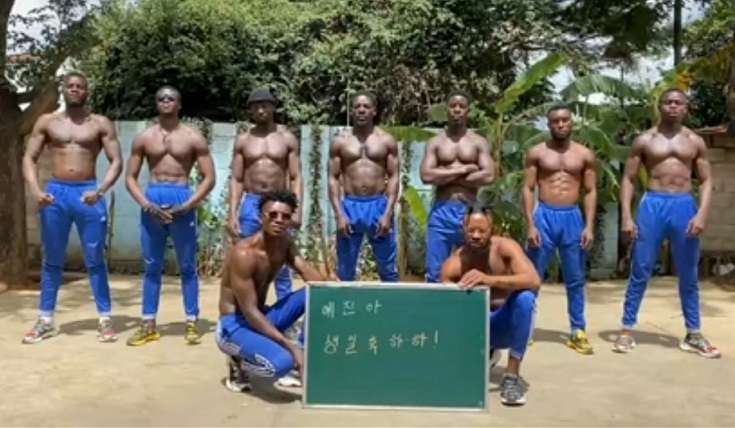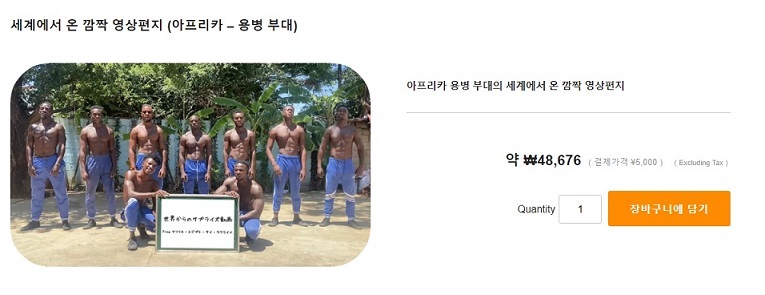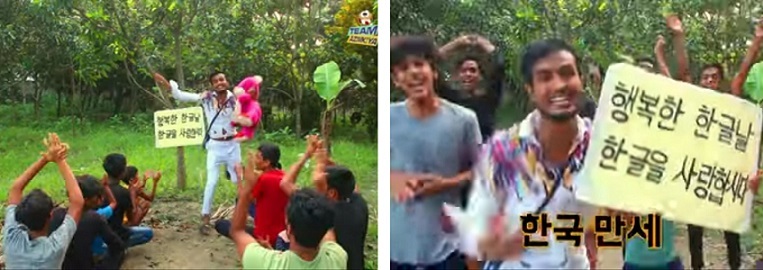These creators barely speak Korean. But they make money out of it.
Foreign creators find niche audience with Korean language
By Choi Jae-heePublished : May 17, 2022 - 09:35

Seven African men with muscular torsos wearing blue sweatpants stand facing the camera. In unison, they say, “Happy birthday, Ye-jin” in Korean.
In front of them, two men, also sporting the same look, hold a chalkboard with the same Korean line written on it.
After the birthday shout out, they all start dancing along to “GANADARA,” a song by Korean singer Jay Park.
This video message, posted on YouTube channel “World Surprise Video” last month, has attracted 60,000 views.
In the comment section, the mostly Korean viewers share how they enjoyed the content and that they plan to send the video to a person named Ye-jin that they know. Others ask the team to create similar videos for their friends or family members.
The video message, spoken in Korean by the unlikely Korean speakers from other side of the world, is a product of Miyabi International based in Taiwan, a new-fangled businesse born out of the Korean language.
“Among various languages, we chose Korean for our video messaging services because the country has been at the forefront of the media and entertainment industry. Its music and films have gained massive global recognition,” said Hiroki Nakayama, a public relations manager for the company.
“Also, we were sure that digital savvy Koreans would enjoy our online contents offered in Korean.”

The company charges 35,000 won ($27.37) for the basic type of video which features foreign performers delivering Korean messages. The price goes up to a maximum of 80,000 won if the client chooses options for an extra charge such as the performers singing and dancing.
“Most of the orders are birthday messages for family members or friends, but there were some peculiar requests, including ‘Don’t forget to flush the toilet, Dad,’ and ‘Lend me some money, dude.’”
Team Azimkiya is another group that produces the “foreigners speaking Korean” videos.

Started by Shipon, 24, living in Dhaka, Bangladesh, their YouTube channel focuses more on introducing Korean historical events or cultures to both Korean and non-Korean viewers.
A video uploaded on Oct. 9, 2021, features seven Bangladeshi men and five boys saying “Happy Hangeul Day” in unison to celebrate the annual national holiday commemorating the invention and proclamation of the Korean alphabet.
At first, Shipon uploaded a video of him learning the Korean language on his personal YouTube account in 2019. It went viral, drawing more than 75,000 subscribers, mostly Koreans, just a week after it was posted.
Since then, Shipon and his neighbors aged between 17-19 started to create personalized video letters in Korean for Korean subscribers based on their requests.
“Korean pronunciation is very difficult. I’ve learned Korean from YouTube contents as well as Naver’s Papago translator. My channel’s videos are not only popular among Koreans, but also among Bangladeshi guys, many of who love Korean culture, especially K-pop. There’s a huge BTS Army in my country,” he said.
The price for a video message provided by Shipon’s crew starts from 17,000 won and varies depending on the number of characters, performers and background songs featured. His team also makes profit by advertising Korean companies’ products, ranging from T-shirts to cosmetic items.
Local experts say the popularity of Korean content, known as the Korean Wave or Hallyu, has led many foreigners to create digital contents involving Korean language in an effort to find new business opportunities.
Korean content being produced by non-Korean speakers reflects Hangeul’s elevated stature from the global popularity of Korean films, TV dramas and music, says Park Gil-ryeong, who teaches social media content at the Korea Association of Vocational Education.
“These video letters made by foreigners can attract not only Korean users but also Hallyu fans across the globe, which seems to be a new online business model,” the expert said.
Foreigners working hard to say Korean words boosts the collective ego of nationalistic Koreans, a psychology professor pointed out.
“Many Koreans, coming from a small country which has achieved a rapid growth in a short period, tend to be enthused by recognition from other countries. Videos of foreigners speaking Korean and promoting Korean culture stirs a sense of national pride,” said Im Myeong-ho, a psychology professor at Dankook University.
By Choi Jae-hee (cjh@heraldcorp.com)







![[KH Explains] How should Korea adjust its trade defenses against Chinese EVs?](http://res.heraldm.com/phpwas/restmb_idxmake.php?idx=644&simg=/content/image/2024/04/15/20240415050562_0.jpg&u=20240415144419)











![[Today’s K-pop] Stray Kids to return soon: report](http://res.heraldm.com/phpwas/restmb_idxmake.php?idx=642&simg=/content/image/2024/04/16/20240416050713_0.jpg&u=)